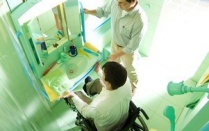Accessible Meetings and Events

Planning in advance will promote access for everyone.
From a staff meeting to a large conference, planning and forethought will promote the accessibility of the event.
Ask in Advance
When issuing an invitation to your event or meeting, ask whether anyone might need an accommodation or assistance. You could say the following: “For questions about accessibility or to request accommodations please contact (name) at (include phone and an email address so that someone with a hearing or verbal disability can make inquiries). Two weeks advance notice will allow us to provide seamless access.”
If you are using a registration form, be sure to include an accessibility statement along with options for accommodation. These could include:
- An interpreter
- An assistive listening device
- Captioning
- Large print
- Copies of notes or other materials in advance
- Wheelchair access
- Dietary restrictions
- Accommodations for an aide who might be accompanying the registrant
Meals and Receptions
If the event will have a social reception and/or meals:
- Include personal assistants and interpreters in the estimated number of participants at no charge to them.
- Make adequate provisions for seating, allowing all participants to sit in the same area. Do not place persons in wheelchairs or those who use walkers or dog guides on the fringes of the dining area.
- If you choose a buffet, have servers available to assist; buffets can be particularly difficult for persons with mobility or visual impairments.
- Determine the accessibility of any outside entertainment and transportation services offered to participants.
Presentations
Communicate with invited speakers and presenters to ensure that presentations are accessible to persons with disabilities.
- Choose well-lit and easily accessible meeting rooms.
- Control background noise to the greatest extent possible.
- Choose a meeting room with good acoustics and an auxiliary sound system, if possible.
- Provide written materials (handouts, overheads, etc.) disseminated at the meeting in a variety of formats as requested by participants, (e.g., raised print, large print, Braille, audiocassette, or computer disks). Providing these in advance will help ensure that they can be accessed.
- Discuss with each presenter prior to the meeting the importance of developing a presentation that will be accessible to all participants.
- Instruct the presenter to include the key points of the presentation on overheads or slides. Be sure they are completely legible, with large print and sharp, contrasting colors. In addition, ask the presenter to limit the number of overheads or other visual aids used in the presentation and to allow adequate time for the audience to read the visual aids.
- Ask the presenter to accompany materials, including presentations and handouts, with a complete verbal description. If slides, overheads, videos or other visual aids are used, the speaker must describe them orally. Ask the presenter to provide a copy of presentation materials well in advance to allow for large print or Braille transcription.
- Check for the needs of presenters with disabilities (ramping or podium requests, a reverse interpreter, sighted guide for a person with limited vision, etc.).
